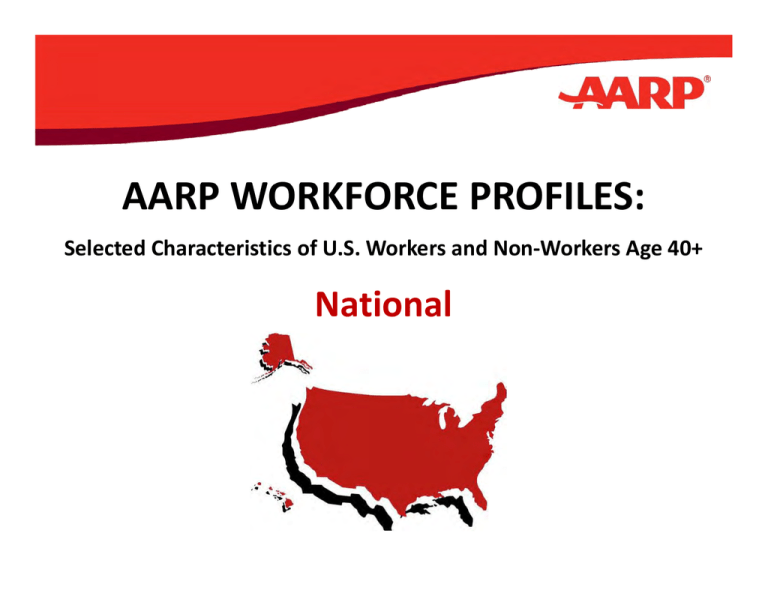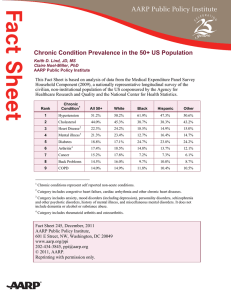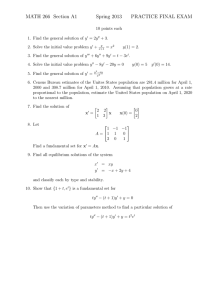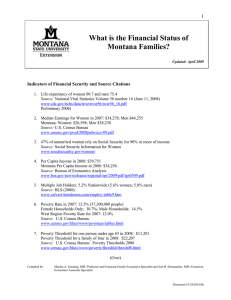AARP WORKFORCE PROFILES AARP WORKFORCE PROFILES: National Selected Characteristics of U.S. Workers and Non‐Workers Age 40+
advertisement

AARP WORKFORCE PROFILES: AARP WORKFORCE PROFILES Selected Characteristics of U.S. Workers and Non‐Workers Age 40+ g National BACKGROUND Undoubtedly, the aging of the 77 million baby boomers – those individuals born between 1946 and 1964 – has impacted the U.S. workforce over the past decade and according to the Bureau of Labor Statistics (BLS), this aging cohort will continue to impact the labor force over the next decade as well. Currently, there are over 144 million individuals in the U.S. age 40 and older, and among them, over 76 million are working. ll C tl th 144 illi i di id l i th U S 40 d ld d th 76 illi ki 1 The BLS Th BLS further projects that in 2020, the 55+ age group will total 97.8 million and will make up over one‐quarter (28.7%) of the resident population and will increase their share of the labor force by 38 percent.2,3 Moreover, while the participation rate of workers age 65 and older has steadily increased since 1990, their participation rate since the start of the recession has considerably surpassed that of workers aged 55‐64.4 By 2020, civilian labor force participation rate for this age group is projected to be 22.6 percent.5 And the BLS notes that not until 2020, when the older baby boomers begin to exit the workforce, will the U.S. labor force begin to experience a downturn in numbers. The AARP Workforce Profiles tool is an electronic and interactive update of the 2005 publication, AARP State Profiles of Workers 45+. Like the earlier publication, this tool is designed to provide specific information about the 40+ workforce nationally and in each state for AARP staff as well as others who work or share an interest in the enhancement of the older U.S. workforce. This tool is intended to provide the user with a broad understanding of this population in order to plan and implement programs related to mature workers. This tool provides information about age 40+ workers within each state such as the number of hours worked per week in which industries they This tool provides information about age 40+ workers within each state, such as the number of hours worked per week, in which industries they work, how many work in the private or public sector, and how they get to work. In addition, the user can view demographic characteristics of workers and non‐workers with respect to health insurance coverage, income, education, disability status, race, gender, and grandparent status. Variables such as type of health coverage and source of income are not available in this hard‐copy report but can be viewed on the interactive online tool: http://www.aarp.org/workforceprofiles. Data were gathered from the 2009‐2011 American Community Survey (ACS) Public Use Micro Sample (PUMS) which is taken from the U S Census Bureau data Data for Puerto Rico are provided from the U.S. Census Bureau Micro Sample (PUMS), which is taken from the U.S. Census Bureau data. Data for Puerto Rico are provided from the U S Census Bureau’ss Puerto Puerto Rico Community Survey (PRCS) 2009‐2011.6 No data are available for the U.S. Virgin Islands from the U.S. Census Bureau. ABOUT THE U.S. CENSUS AMERICAN COMMUNITY SURVEY The data behind this tool comes from the Census Bureau’s American Community Survey (ACS). The ACS is an ongoing survey that samples a small percentage of the population every year in the United States and Puerto Rico – rather than from the whole population like the decennial census. percentage of the population every year in the United States and Puerto Rico rather than from the whole population like the decennial census Foremost, data from the ACS determines how federal and state funds are distributed each year to states and local communities but the data are available for public use for a variety of purposes. All ACS data are survey estimates and not exact numbers and proportions in a point in time. The data are available in 1, 3, and 5‐year period estimates so data are combined to produce 12 months, 36 months or 60 months of data. 1. U.S. Census Bureau, Current Population Survey, Annual Social and Economic Supplement, 2012 , p y, pp , 2. Toossi, M. Labor Force Projections to 2020: A More Slowly Growing Workforce, see Table 1, p. 44 3. Ibid, Toossi, p. 45 4. Rix, S. The Employment Situation, October 2012: Relatively Little Change for Older Workers, p. 6 5. Ibid, Toossi. p. 50 6. Please go to http://www.census.gov/acs/www/about_the_survey/puerto_rico_community AARP WORKFORCE PROFILES: Selected Characteristics of U.S. Workers and Non‐Workers Age 40+ The American Community Survey Public Use Microdata Sample, or PUMS, is a data set of un‐tabulated records of individual people or housing units produced by the Census Bureau. As with all Census information, PUMS files are available to the public and allow users access to inexpensive data for custom tables regression analysis or modeling applications not available with the pre tabulated ACS data data for custom tables, regression analysis, or modeling applications not available with the pre‐tabulated ACS data. For more information about the American Community Survey, go to http://www.census.gov/acs/www/guidance_for_data_users/guidance_main/ For more information about PUMS, go to http://www.census.gov/acs/www/data_documentation/public_use_microdata_sample/ To learn more about how the ACS differs from other labor statistics, go to http://www.census.gov/hhes/www/laborfor/laborguidance092209.html GUIDE TO INTERPRETING TABLES In order to improve the precision of the estimates at the state level, particularly for smaller or less populated states, the 3‐year 2009‐2011 ACS PUMS data was used for this analysis. As a result, the data presented here technically represent average values over the three year period. The National un‐weighted sample for the U.S. population age 40+ in this dataset is 4,727,802. Sample size and margins of error remain an issue for some subgroups and caution must be used when making inferences in these cases. Simply put, the margin of error describes how far a sample’s results stray from the true value of an entire population. The smaller the margin of error, the greater likelihood the sample is representative of the y p p g , g p p population. Given that the ACS is a survey of a sample of people drawn from the larger population, smaller states like Wyoming or Delaware are likely to yield small samples of the U.S. population, and therefore yield a smaller number of respondents and larger margins of error within subgroups such as the number of workers age 50+ with no health coverage. On the other hand, more populated states like California are likely to yield greater numbers of respondents and smaller margins of error within subgroups, making inferences to the larger state population more reliable. This tool does not provide p g g p, g g p p p a way for users to test for significance between estimates, so use caution when comparing geographies as differences may not be meaningful. Cautionary notes are also included throughout the tool in cases where the unweighted sample size for a particular state is less than 1,000. The margin of error for a sample of 1,000 at the 95% confidence interval is +/‐ 3.1 percent. DEFINITIONS For purposes of this tool employment related terms are defined as follows: For purposes of this tool, employment‐related terms are defined as follows: workers/employed: includes those working as paid employees, working for profit in own business or profession, on their farm, or for 15 hours or more unpaid on family farm or in family business; also includes those on active duty in U.S. Armed Forces (part of ACS "labor force" definition). non‐workers: includes the unemployed and those not in the labor force (i.e., both of the categories below). unemployed: includes those not working as a paid employee, and those actively looking for work and available to start a job. not in the labor force: includes students, homemakers, retired workers, seasonal workers interviewed in an off season who were not looking for work, institutionalized people, or those doing unpaid family work for less than 15 hours per week. For more information on ACS employment definitions please go to http://www.census.gov/people/laborforce/about/acs_employ.html. AARP WORKFORCE PROFILES: Selected Characteristics of U.S. Workers and Non‐Workers Age 40+ National PROFILE Selected Characteristics of U.S. Workers and Non‐Workers Age 40+ by Age Group 40+ Workers 40 to 49 50 to 64 65+ Gender % % % Male 52.5% 51.5% 55.4% Female 47.5% 48.5% 100.0% 100.0% Group Total Education % % 40+ Non‐Workers Total 65+ Total % % % % Count % 40,395,031 52.2% 40.1% 43.0% 41.0% 27,341,061 41.5% 67,736,092 47.3% 44.6% 36,918,444 47.8% 59.9% 57.0% 59.0% 38,549,229 58.5% 75,467,673 52.7% 100.0% 77,313,475 100.0% 100.0% 100.0% 100.0% 65,890,290 100.0% 143,203,765 100.0% % Count 40 to 49 50 to 64 Total Population Count % % % % Count % Count Count % % None 0.7% 0.8% 1.1% 618,391 0.8% 2.2% 2.2% 2.6% 1,575,996 2.4% 2,194,387 1.5% Some preschool ‐ 6th grade 2.0% 1.7% 1.8% 1,440,929 1.9% 3.3% 3.4% 4.3% 2,516,995 3.8% 3,957,924 2.8% 7th‐12th grade 6.6% 5.8% 8.9% 4,922,295 6.4% 16.9% 13.6% 17.2% 10,544,131 16.0% 15,466,426 10.8% High school graduate 26.5% 26.9% 28.5% 20,746,292 26.8% 32.9% 32.6% 35.3% 22,439,907 34.1% 43,186,199 30.2% Some college /Associate 31.0% 31.0% 26.5% 23,708,663 30.7% 27.5% 28.5% 21.5% 16,267,097 24.7% 39,975,760 27.9% College graduate/post graduate 33.2% 33.8% 33.1% 25,876,905 33.5% 17.3% 19.7% 19.2% 12,546,164 19.0% 38,423,069 26.8% 100.0% 100.0% 100.0% 77,313,475 100.0% 100.0% 100.0% 100.0% 65,890,290 100.0% 143,203,765 100.0% Group Total Income % % % Less than $25,000 27.0% 25.5% 25.9% $25,000 to $49,999 32.7% 32.1% $50,000 to $99,999 28.6% $100,000 to $249,999 $250,000 or more G Group Total T t l Count % % % % Count % 20,219,742 26.2% 89.1% 78.1% 69.2% 49,553,309 75.2% 69,773,051 48.7% 34.7% 25,169,873 32.6% 7.2% 13.6% 20.6% 10,699,893 16.2% 35,869,766 25.0% 29.5% 25.2% 22,256,028 28.8% 2.8% 6.2% 7.5% 4,191,929 6.4% 26,447,957 18.5% 9.7% 10.5% 11.1% 7,878,214 10.2% 0.8% 1.9% 2.4% 1,280,479 1.9% 9,158,693 6.4% 2.0% 2.4% 3.1% 1,789,618 2.3% 0.1% 0.2% 0.3% 164,680 0.2% 1,954,298 1.4% 100 0% 100.0% 100 0% 100.0% 100 0% 100.0% 77 313 475 77,313,475 100 0% 100.0% 100 0% 100.0% 100 0% 100.0% 100 0% 100.0% 65 890 290 65,890,290 100 0% 143,203,765 100.0% 143 203 765 100 0% 100.0% Source: U.S. Census Bureau, American Community Survey, Public Use Microdata Sample 2009‐2011 AARP WORKFORCE PROFILES: Selected Characteristics of U.S. Workers and Non‐Workers Age 40+ Count % National PROFILE Selected Characteristics of U.S. Workers and Non‐Workers Age 40+ by Age Group 40 W k 40+ Workers 40 to 49 50 to 64 65+ Race % % % Caucasian/White 67.0% 75.2% 80.8% / African American/Black 11.2% 9.5% 5.5% 40 N W k 40+ Non‐Workers Total 40 to 49 50 to 64 Total % % % % 55,761,926 72.1% 59.4% 69.6% 79.7% 48,284,134 73.3% 104,046,060 72.7% 7.8% 7,806,849 , , 10.1% 16.3% 13.6% 8.5% 7,487,663 , , 11.4% 15,294,512 , , 10.7% 4.6% 3.7% 3,790,632 4.9% 4.8% 4.0% 3.5% 2,568,292 3.9% 6,358,924 4.4% 14.4% 9.2% 6.4% 8,670,086 11.2% 16.7% 10.5% 7.0% 6,382,459 9.7% 15,052,545 10.5% American Indian/Alaska Native 0.5% 0.5% 0.4% 390,654 0.5% 1.0% 0.8% 0.4% 422,114 0.6% 812,768 0.6% / Other/two or more races 1.3% 1.0% 0.9% , 893,328 1.2% 1.7% 1.4% 0.8% 745,628 , 1.1% 1,638,956 , , 1.1% 100.0% 100.0% 100.0% 77,313,475 100.0% 100.0% 100.0% 100.0% 65,890,290 100.0% 143,203,765 100.0% Asian/Pacific Islander Hispanic any race Group Total Grandparent Status % % % No grandchildren in the home 97.4% 95.0% 95.2% Responsible for grandchildren 1.3% 2.3% Not responsible for grandchildren 1.3% 100.0% Group Total Disability Status With a disability Without a disability Group Total % 74,232,539 96.0% 96.1% 92.5% 95.1% 62,233,857 1.8% 1,421,319 1.8% 2.0% 2.9% 1.1% 1,197,234 1.8% 2,618,553 1.8% 2.8% 3.0% 1,659,617 2.1% 1.9% 4.6% 3.8% 2,459,199 3.7% 4,118,816 2.9% 100.0% 100.0% 77,313,475 100.0% 100.0% 100.0% 100.0% 65,890,290 100.0% 143,203,765 100.0% % % % % Count Count % % Count % Count % % Count % % % Count Count % 94.5% 136,466,396 % Count % 95.3% % 4.8% 7.9% 16.6% 5,606,849 7.3% 26.8% 34.2% 42.6% 24,648,460 37.4% 30,255,309 21.1% 95.2% 92.1% 83.4% 71,706,626 92.7% 73.2% 65.8% 57.4% 41,241,830 62.6% 112,948,456 78.9% 100.0% 100.0% 100.0% 77,313,475 100.0% 100.0% 100.0% 100.0% 65,890,290 100.0% 143,203,765 100.0% Health Coverage % % % Yes 85.2% 89.3% 98.7% No 14.8% 10.7% 100.0% 100.0% Group Total Count 65+ Total Population Count % % % % 68,214,040 88.2% 67.1% 80.5% 99.1% 58,050,517 88.1% 126,264,557 88.2% 1.3% 9,099,435 11.8% 32.9% 19.5% 0.9% 7,839,773 11.9% 16,939,208 11.8% 100.0% 77,313,475 100.0% 100.0% 100.0% 100.0% 65,890,290 100.0% 143,203,765 100.0% Source: U.S. Census Bureau, American Community Survey, Public Use Microdata Sample 2009‐2011 AARP WORKFORCE PROFILES: Selected Characteristics of U.S. Workers and Non‐Workers Age 40+ Count % Count % National PROFILE Selected Characteristics of U.S. Workers Age 40+ by Age Group 40+ Workers Age 40 to 49 Number of Hours Worked Per Week 1 – 19 hours Count Age 50 to 64 % 1,114,180 3.4% Count Age 65+ % Count Total % Count % 1,706,167 4.5% 1,194,087 19.8% 4,014,434 5.2% 5,914,559 17.9% 7,584,876 19.9% 2,048,848 34.0% 15,548,283 20.1% 40+ hours 26,069,420 78.8% 28,896,322 75.7% 2,785,016 46.2% 57,750,758 74.7% Group Total 33,098,159 100.0% 38,187,365 100.0% 6,027,951 100.0% 77,313,475 100.0% 20 – 39 hours Class of Worker Count % Count % % Count % Private, for‐profit 21,329,565 64.4% 22,191,039 58.1% 3,078,326 51.1% 46,598,930 60.3% Private, not‐for‐profit 2,525,382 7.6% 3,524,235 9.2% 688,804 11.4% 6,738,421 8.7% Government 5,506,751 16.6% 7,252,622 19.0% 909,677 15.1% 13,669,050 17.7% Self‐employed 3,693,183 11.2% 5,163,873 13.5% 1,331,222 22.1% 10,188,278 13.2% 43 278 43,278 0 1% 0.1% 55 596 55,596 0 1% 0.1% 19 922 19,922 0 3% 0.3% 118 796 118,796 0 2% 0.2% Group Total 33,098,159 100.0% 38,187,365 100.0% 6,027,951 100.0% 77,313,475 100.0% Industry Count Working without pay in family business or farm Working without pay in family business or farm % Count % Count Count % Count % Agriculture 414,583 1.3% 540,805 1.4% 160,033 2.7% 1,115,421 1.4% Mining 164,444 0.5% 215,622 0.6% 19,803 0.3% 399,869 0.5% Utilities 330,849 1.0% 464,965 1.2% 28,845 0.5% 824,659 1.1% Construction 2,361,609 7.1% 2,264,070 5.9% 241,510 4.0% 4,867,189 6.3% Manufacturing 4,144,895 12.5% 4,700,910 12.3% 437,536 7.3% 9,283,341 12.0% Wholesale 1,050,603 3.2% 1,187,522 3.1% 188,046 3.1% 2,426,171 3.1% Retail 3,088,584 9.3% 3,663,860 9.6% 813,957 13.5% 7,566,401 9.8% Transportation 1,602,773 4.8% 1,935,406 5.1% 247,753 4.1% 3,785,932 4.9% 735,098 2.2% 743,441 1.9% 95,031 1.6% 1,573,570 2.0% Finance, Insurance, Real Estate 2,344,919 7.1% 2,636,091 6.9% 480,582 8.0% 5,461,592 7.1% Professional and Scientific Services 3,606,252 10.9% 3,831,049 10.0% 715,931 11.9% 8,153,232 10.5% Educational, Health, and Social Services 7,529,179 22.7% 9,873,553 25.9% 1,454,707 24.1% 18,857,439 24.4% Arts, Entertainment, Recreation, Accommodation, Food Services 3,657,231 11.0% 3,832,364 10.0% 875,190 14.5% 8,364,785 10.8% Public Administration Public Administration 1,929,659 5.8% 2,273,186 6.0% 269,027 4.5% 4,471,872 5.8% Information Military Group Total 137,481 0.4% 24,521 0.1% 0 0.0% 162,002 0.2% 33,098,159 100.0% 38,187,365 100.0% 6,027,951 100.0% 77,313,475 100.0% Source: U.S. Census Bureau, American Community Survey, Public Use Microdata Sample 2009‐2011 AARP WORKFORCE PROFILES: Selected Characteristics of U.S. Workers and Non‐Workers Age 40+ National PROFILE Selected Characteristics of U.S. Workers Age 40+ by Age Group 40+ Workers Age 40 to 49 Count Transportation to Work Age 50 to 64 % % Count % 4,849,966 80.5% 65,695,530 85.0% 816,044 2.1% 118,255 2.0% 1,666,571 2.2% 19,623 0.1% 2,227 0.0% 38,152 0.0% 1.4% 483,056 1.3% 56,247 0.9% 1,015,893 1.3% 0.6% 216,847 0.6% 26,786 0.4% 444,006 0.6% 10,007 0.0% 12,206 0.0% 1,141 0.0% 23,354 0.0% 33,195 0.1% 38,634 0.1% 7,976 0.1% 79,805 0.1% 28,363,151 Bus or trolley bus Count % 85.7% 32,482,413 732,272 2.2% 16,302 0.0% Subway or elevated train 476,590 Railroad 200,373 Ferryboat Taxicab Count Total 85.1% Car, truck, or van Streetcar or trolley car (carro publico in Puerto Rico) Age 65+ 71,640 0.2% 84,043 0.2% 6,327 0.1% 162,010 0.2% Bicycle 133,680 0.4% 128,528 0.3% 13,276 0.2% 275,484 0.4% Walked 623 387 623,387 1 9% 1.9% 761 490 761,490 2 0% 2.0% 167 074 167,074 2 8% 2.8% 1 551 951 1,551,951 2 0% 2.0% 1,497,299 4.5% 1,978,375 5.2% 546,623 9.1% 4,022,297 5.2% 255,372 0.8% 269,331 0.7% 44,128 0.7% 568,831 0.7% Motorcycle Worked at home Other method N/A (not a worker‐‐not in the labor force) Group Total 684,891 2.1% 896,775 2.3% 187,925 3.1% 1,769,591 2.3% 33,098,159 100.0% 38,187,365 100.0% 6,027,951 100.0% 77,313,475 100.0% Source: U.S. Census Bureau, American Community Survey, Public Use Microdata y y Sample 2009‐2011 p National PROFILE Employment Status for Americans Age 50+ by Gender Employed National Male Female % % 49.9% Unemployed Total Count 39.7% 44,215,316 % 44.4% Male Female Total % % Count % 4.5% 2.9% 3,646,383 3.7% Male Female % % 45.6% Source: U.S. Census Bureau, American Community Survey, Public Use Microdata Sample 2009‐2011 AARP WORKFORCE PROFILES: Selected Characteristics of U.S. Workers and Non‐Workers Age 40+ Total Not in Labor Force Total Count 57.4% 51,661,199 % Male Female Total Count Count Count 51.9% 46,102,018 53,420,880 99,522,898 ADDITIONAL RESOURCES AARP Public Policy Institute, Economic Security AARP Research and Statistics, Economic Security and Work AARP State Profiles of Workers 45+ (2005) American Community Survey American Community Survey, Public Use Microdata Sample (PUMS) American Community Survey Questionnaire Bureau of Labor Statistics Bureau of Labor Statistics, Economy at a Glance Center for Retirement Research at Boston College Kaiser Family Foundation, Demographics and the Economy U.S. Census Bureau Current Population Survey U.S. Census Bureau Local Employment Dynamics U.S. Department of Labor U.S. Department of Labor COBRA Continuation Coverage U.S. Department of Labor Services by Location U.S. Census Bureau Local Employment Dynamics, Community E Economic Development i D l t ACKNOWLEDGMENTS Staff from AARP’s Research and Strategic Analysis, Education and Outreach, and Digital Strategy and Operations contributed to the development of this tool. Jennifer Sauer provided coordination of the project; Rosa Maymi and Elizabeth Buser provided content guidance; Charlotte Spinner utilized the Cuadra STAR® information management suite to create this tool; Sibora Gjecovi provided the data from the U.S. Census Bureau utilized the Cuadra information management suite to create this tool; Sibora Gjecovi provided the data from the U S Census Bureau’ss American Community Survey Pete Wiley and Andrew Wilson provided guidance on the AARP web site design and implementation. For questions or comments regarding the tool or the data, please contact Jennifer H. Sauer at workforceprofiles@aarp.org or (202) 434‐6207. For more information on older worker issues and AARP programs, please contact Rosa Maymi at rmaymi@aarp.org or (202) 434‐3906. For more information on the U.S. Census American Community Survey, please go to http://www.census.gov/acs/www/. AARP is a nonprofit, nonpartisan organization with a membership that helps people 50+ have independence, choice, and control in ways that are beneficial and affordable to them and society as a whole. AARP does not endorse candidates for public office or make contributions to either political campaigns or candidates. We produce AARP The Magazine, the definitive voice for 50+ Americans and the world's largest‐circulation magazine with over 35.1 million readers; AARP Bulletin, the go‐to news source for AARP's millions of members and Americans 50+; AARP VIVA, the only bilingual U S publication dedicated exclusively to the 50+ Hispanic community; and our website AARP org AARP Foundation is an affiliated charity that U.S. publication dedicated exclusively to the 50+ Hispanic community; and our website, AARP.org. AARP Foundation is an affiliated charity that provides security, protection, and empowerment to older persons in need with support from thousands of volunteers, donors, and sponsors. We have staffed offices in all 50 states, the District of Columbia, Puerto Rico, and the U.S. Virgin Islands. The views expressed herein are for information, debate, and discussion, and do not necessarily represent official policies of AARP. Locate the interactive AARP Workforce Profiles at http://www.aarp.org/workforceprofiles and other AARP research at http://www.aarp.org/research AARP WORKFORCE PROFILES: Selected Characteristics of U.S. Workers and Non‐Workers Age 40+







